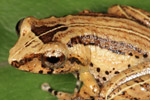Biologists recently documented one of nature’s least-known, big events. On the banks of the Purus River in the Brazilian Amazon, researchers witnessed the mass-hatching of an estimated 210,000 giant South American river turtles (Podocnemis expansa). The giant South American river turtle, or Arrau, is the world’s largest side-necked turtle and can grow up to 80 centimeters long (nearly three feet).
Researchers with the Wildlife Conservation Society (WCS) and the Chico Mendes Institute for Biodiversity Conservation marked and released 15,000 (around 7 percent) of the newly-born hatchlings in the Abufari Biological Reserve. Future surveys of the species will allow researchers to collect data on the individually-marked turtles in an effort to better protect them in the future.
Only a small percentage of the hundreds of thousands of hatchlings are expected to survive to adult. Mass-hatching is a strategy used by some other turtle species, most famously sea turtles, in order to overwhelm predators and allowing a small number to squeak into adulthood.
.600.jpg)
A giant South American river turtle hatchling emerges from its shell. Photo by: C. Ferrara/Wildlife Conservation Society.
“Turtles are among the most endangered species of vertebrates in the region and worldwide,” notes Julie Kunen, Executive Director of WCS’s Latin America and the Caribbean Program. “Monitoring programs for these and other turtles and tortoises will provide a foundation for sound management plans in the years to come.”
Although listed as Least Concern by the IUCN Red List, the giant South America side-necked turtle is imperiled by overconsumption of its meat and eggs by local people. It has not been formally evaluated by the IUCN since 1996.
.600.jpg)
Researchers used a fence to contain the turtle hatchlings emerging from identified nests in order to mark and release many of the turtles to keep tabs on the population. Photo by: C. Ferrara/Wildlife Conservation Society.
.600.jpg)
The mass hatching event in Brazil’s Abufari Biological Reserve. Photo by: C. Ferrara/Wildlife Conservation Society.
.600.jpg)
Mass hatching event. Photo by: C. Ferrara/Wildlife Conservation Society.

A lucky adult giant South American river turtle. Few of the hundreds of thousands of hatchlings will ever make it to adulthood. Photo by: C. Ferrara/Wildlife Conservation Society.
Related articles
‘Flying snakes’ achieve surprising lift through unique body shape

(02/04/2014) Flying snakes achieve surprising amounts of lift through the shape of their bodies, report researchers from Virginia Tech in a paper recently published in the Journal of Experimental Biology. The study examined how paradise tree snakes—one of five species of so-called flying snake found in Southeast Asia—shape their bodies to achieve the lift that allows them to glide up to 30 meters between trees.
287 amphibian and reptile species in Peruvian park sets world record (photos)

(01/28/2014) It’s official: Manu National Park in Peru has the highest diversity of reptiles and amphibians in the world. Surveys of the park, which extends from high Andean cloud forests down into the tropical rainforest of the Western Amazon, and its buffer zone turned up 155 amphibian and 132 reptile species, 16 more than the 271 species documented in Ecuador’s Yasuní National Park in 2010.
One lizard, four species: the collared treerunner

(01/21/2014) Now, that’s a horse of a different color. Or, in this case, a lizard of another species–four species. Recent research suggests that the collared treerunner (Plica plica), previously thought of as one widespread species, is actually four distinct species inhabiting diverse geographical areas east of the Andes in northern South America.
Red toad discovered in the upper reaches of the Amazon
(01/19/2014) Scientists have described a previously unknown species of toad in the Peruvian Andes.
High-living frogs hurt by remote oil roads in the Amazon

(01/14/2014) Often touted as low-impact, remote oil roads in the Amazon are, in fact, having a large impact on frogs living in flowers in the upper canopy, according to a new paper published in PLOS ONE. In Ecuador’s Yasuni National Park, massive bromeliads grow on tall tropical trees high in the canopy and may contain up to four liters of standing water. Lounging inside this micro-pools, researchers find a wide diversity of life, including various species of frogs. However, despite these frogs living as high as 50 meters above the forest floor, a new study finds that proximity to oil roads actually decreases the populations of high-living frogs.
Not seen in over 130 years, ‘extinct’ frog rediscovered in Sri Lanka

(01/10/2014) In 1876—the same year that the first telephone call was made—the British scientist Albert Günther described a new species of frog from Sri Lanka, but the species, known as the webless shrub frog (Pseudophilautus hypomelas), was never seen again. Having disappeared into history, scientists considered the species extinct—that is until a 2010 expedition stumbled on 40 mystery frogs.